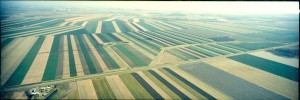Intercropping refers to the cultivation of two or more crops in one field, either spatially (e.g. strip intercropping) or temporally (e.g. crop rotations).
Advantages of intercropping
- Increases the diversity of a farming system
- Reduces risk
- Provides greater stability
- Can reduce pest and disease incidence.
Intercropping layouts
- Strip intercropping is when two or more crops are grown side by side in strips, wide enough to permit independent cultivations but close enough for crops to interact.
- Row intercropping means growing 2 or more crops in well defined rows.
- Relay intercropping refers to the planting of a second crop into the standing crop at the time when the standing crop is at a reproductive stage but before harvest.
- Crop rotation involves different crops in the field at different times of the year
Studies into the effects of intercropping on pest populations have shown mixed results. In general, pests with a narrow host range are more likely to show reductions in numbers when crop diversity is increased. This could be due to increased difficulty in locating potential hosts. Paddocks with increased diversity may also be more conducive to attracting and maintaining beneficial insect populations.
Trap cropping and living mulches
Trap crops are specifically planted to entice a pest away from the main crop. While they can be intercropped, they are more often planted in a discrete portion of the field for ease of management. They can be either a different species, or the same as the main crop, but planted earlier. Trap crops need to be carefully managed to avoid them becoming a source of pest build-up and re-infection back into the primary crop. Trap crops are generally timed to a key point in the pest’s lifecycle, and then harvested or destroyed before that lifecycle finishes and the pest transfers back into the main crop.
Living mulches are minor crops or non-crop plants that are intercropped with the primary crop to influence pest and beneficial populations and add organic matter to the soil. They are most commonly used in vegetable systems.
Further information
- Intercropping, Crop Diversity and Pest Management (University of Florida)
- Francisco R. Badenes-perez, Anthony M. Shelton, and Brian A. Nault (2005). Using Yellow Rocket as a Trap Crop for Diamondback Moth (Lepidoptera: Plutellidae). Journal of Economic Entomology 98(3):884-890. 2005
- Stink bug management using trap crops in organic farming (extension.org)
- Trap crops, intercropping and companion planting


